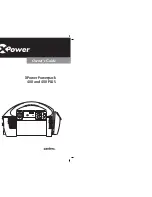
Recommendations on using the XMP 2600
Usage Guidelines
Identify the XMP 2600
Using the *IDN? query, it is possible to verify that the device you are communicating
with is indeed a XMP 2600 power system.
The *IDN? query also returns the firmware revision code for the XMP’s main controller.
Use the GPIB? query to make sure the XMP 2600 is operating in IEEE488.2 mode.
Enforce power-on conditions
Power-on retain
Using the XMP 2600 in a computer controlled environment eliminates the need to use the
Power On Retain feature because the controlling computer can easily re-program the
XMP 2600 to a required state.
Therefore, set the Power On Retain feature to OFF (or NO). This can be done manually
(using the front panel, in setup mode) or using the POR command. The XMP 2600 will
remember your selection when it is turned off.
Clear / Retain Event Enable Registers
Similar to the Power On Retain issue, it is better to let the XMP 2600 clear the Event
Enable Registers at power-on.
Clearing the Event Enable Registers is the default behavior of the XMP 2600 at power-
on. Using the *PSC command, the XMP 2600 can be instructed to the behavior suitable
for the user.
Use a CLR or RESET command
Use either the CLR (clear) or the RESET command to force the XMP 2600 to its initial
conditions.
The RESET command will set the XMP 2600 to the exact state it would be in following
turn-on.
The CLR command is similar to the RESET command with the following differences:
It will take the minimum number of actions necessary to set the XMP 2600
to its turn-on state. In contrast to the RESET command, Power Modules
will not be reset if not necessary for clearing malfunctions.
The XMP 2600 main status structure is not cleared.
Following a CLR or RESET command you should wait for 15 seconds before attempting
to communicate with the XMP 2600.
Setup the XMP 2600 status system
Before dealing with the Power Modules and to complete the XMP 2600 power system
initialization, you should setup the mask registers of the XMP’s main controller status
structure.
Use commands like *ESE, *PRE, *SRE and PEE to setup the XMP’s event and SRQ
generation masks.
Query installed Power Modules
Before using the XMP 2600 power system, it is a good practice to make sure that the
system contains the Power Modules that you expect it to have.
8
XMP 2600 Programming Manual
rev. 1.1
















































